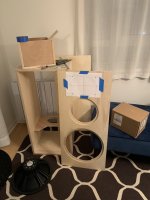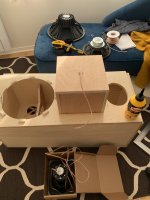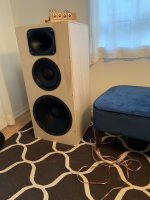So, I decided to test a tri amped Faital pro with digital crossover.
Drivers:
15pr400
10pr320
Hf108r with lth102
Building this monstrosity in my Parisian apartment is a bit of a chore.
Even with this cheap 20mm plywood, my palm router struggled with the holes. I screwed the baffle and the back, to be able to disassemble it later.
It’s 160l internal minus 19l for the mid box.
Winisd gives me a nice curve at 43Hz with two 100mm ports, of length ~100mm
Now I have to hook it up my minidsp and use three channel in mono to see if I can get something satisfactory out of it.
Drivers:
15pr400
10pr320
Hf108r with lth102
Building this monstrosity in my Parisian apartment is a bit of a chore.
Even with this cheap 20mm plywood, my palm router struggled with the holes. I screwed the baffle and the back, to be able to disassemble it later.
It’s 160l internal minus 19l for the mid box.
Winisd gives me a nice curve at 43Hz with two 100mm ports, of length ~100mm
Now I have to hook it up my minidsp and use three channel in mono to see if I can get something satisfactory out of it.
Attachments
All good drivers by all accounts, using the same basic format I have for over 25y, so it should sound very good. I hope you enjoy them.
So, some preliminary measurements this morning, I will need to ask for your help if anyone's willing 🙂
This is the midrange near field, it's in a sealed box, with no dampening: lot of dips and peaks between 500 and 2000Hz. Actually planned a xover at 1600.

Bass is pretty terrible, there is some sort of resonance (?) at 159Hz and 600Hz , maybe some dampening at the bottom would help? Crossover planned around 200Hz.

horn is actually ok with a FR that matches the expectation.

measurement setup with my photography tripods. Wonder if not using an arm actually has an effect?
![IMG_0065[4788].jpg IMG_0065[4788].jpg](https://www.diyaudio.com/community/attachments/img_0065-4788-jpg.1178727/)
This is the midrange near field, it's in a sealed box, with no dampening: lot of dips and peaks between 500 and 2000Hz. Actually planned a xover at 1600.
Bass is pretty terrible, there is some sort of resonance (?) at 159Hz and 600Hz , maybe some dampening at the bottom would help? Crossover planned around 200Hz.
horn is actually ok with a FR that matches the expectation.
measurement setup with my photography tripods. Wonder if not using an arm actually has an effect?
Hi,
yeah add damping and measure again. Keep path from driver to port(s) clear but you could fill top of the box for example.
Bass, 150Hz stuff is most likely standing wave between top and bottom of the box. Since ports are on the back the ~450Hz stuff is probably resonance between driver and the backside of box and not registered by the mic near cone, so some damping material on the back wall (inside the box).
Mid, if you look datasheets of any 8-10" mid ranges every single one has wiggle on impedance plot for the whole mid range telling cone resonances start quite low and stuff like that. Perhaps reflections inside the box, edge diffraction outside of the box, first reflections in the room, breakup. Basically all loudspeaker "issues" fall on the midrange roughly between 300Hz - 2kHz and response is easily quite rough, due to multiple things.
If you do some off-axis measurements preferably the whole spinorama thing, you'll get more information what is what in the responses to better understand what the acoustic output of the system is.
yeah add damping and measure again. Keep path from driver to port(s) clear but you could fill top of the box for example.
Bass, 150Hz stuff is most likely standing wave between top and bottom of the box. Since ports are on the back the ~450Hz stuff is probably resonance between driver and the backside of box and not registered by the mic near cone, so some damping material on the back wall (inside the box).
Mid, if you look datasheets of any 8-10" mid ranges every single one has wiggle on impedance plot for the whole mid range telling cone resonances start quite low and stuff like that. Perhaps reflections inside the box, edge diffraction outside of the box, first reflections in the room, breakup. Basically all loudspeaker "issues" fall on the midrange roughly between 300Hz - 2kHz and response is easily quite rough, due to multiple things.
If you do some off-axis measurements preferably the whole spinorama thing, you'll get more information what is what in the responses to better understand what the acoustic output of the system is.
Last edited:
Thanks tmuikku!
Dampening did help a bit with the resonance at 160Hz and the peak at 850Hz completely disappeared, I wish everything were so simple... I will wait until I get the real ports to test further as my homemade tubes are a bit wonky and I suspect the 150Hz hiccup is from the ports.
Did a basic crossover using the minidsp SHD, and I am playing with the PEQ and LR slopes live to find what pleases me best, I like to pretend I am that good 😎
I will do a FR sweep with these settings later.
Dampening did help a bit with the resonance at 160Hz and the peak at 850Hz completely disappeared, I wish everything were so simple... I will wait until I get the real ports to test further as my homemade tubes are a bit wonky and I suspect the 150Hz hiccup is from the ports.
Did a basic crossover using the minidsp SHD, and I am playing with the PEQ and LR slopes live to find what pleases me best, I like to pretend I am that good 😎
I will do a FR sweep with these settings later.
The bass box looks noisy, as I had similar stuff before, so try steep filter for the low crossover. It makes worse group delay, which you might perceive, but should reduce noise of the box and clear the mids out some, trust your ears on this 🙂 Big boxes are tough to make, and big panels can make lot of noise, resonances inside and so on. I now have 50litre boxes, rather generous damping, and seems much better than ~80l or 120l boxes with poor damping. Of course lows are now less, but I can compensate adding more power, more drivers 😉
If the mid driver is operating in breakup through its operating range (and I trust tmuikku to know such things), you should experiment with various stuffing materials and stuffing densities within the midrange box. You want to make sure that any acoustical resonances within the midrange box do not add to the cone/surround resonances.. i.e. make sure they do not happen at the same frequency. When dealing with a less than perfect situation, tweaking can make a big difference.Mid, if you look datasheets of any 8-10" mid ranges every single one has wiggle on impedance plot for the whole mid range telling cone resonances start quite low and stuff like that.
Cool project !
j.
Yeah of course I have actually tried only few 🙂 Initialy I bought a driver that seemed suitable, but was shocked how bad the response was, like ldarieut. Looked around and I could not find (pa market) 8" driver with clean blip free impedance plot in datasheet so I just reason its the case with such drivers. I hope there is at least one somewhere I didn't look 🙂 on the other had the driver I got is pistonic enough up to say 1kHz-2kHz that EQ works just fine. Rresponse is equally lumpy to all directions.
Last edited:
From this calculator:
it looks like all the standing waves are in the same range where I have all the peaks and dips.
This one is gone with the damping:

and here is the damping, one layer was added at the top:

This stuff is recycled clothes, with supposedly very good phonic insulation and 4,5cm thick, that's 1 3/4 inches for the imperialists. Should I put more?
Mode | Height | Width | Depth |
1 | 794 Hz | 660 Hz | 858 Hz |
2 | 1.59 KHz | 1.32 KHz | 1.72 KHz |
it looks like all the standing waves are in the same range where I have all the peaks and dips.
This one is gone with the damping:
and here is the damping, one layer was added at the top:
This stuff is recycled clothes, with supposedly very good phonic insulation and 4,5cm thick, that's 1 3/4 inches for the imperialists. Should I put more?
If you can do impedance sweep you'll see blips there, add damping until all blips that reduce with damping are gone. If considerable blip is now gone in your FR plot I'd say its probably enough and adding more wouldn't bring much difference.
People seem to say too much damping is also possible and perhaps affects sound negatively. You can monitor the main resonance peak in impedance plot and if it deforms, there is too much. I don't know how much that is, or how it sounds. Enough damping, no surpririsingly, dampens the woofer main resonance (easily monitored with impedance sweep) so system Q drops. Whether this is good or bad thing is up to you, you can always EQ it to what ever you like since you have a DSP. This could be something that can make some systems sound "too damped" which makes people say one should not put too much damping, which makes it context dependent advice mainly concerning systems without DSP. Although, there is no point damping too much as its waste of material so in that sense its a reasonable general advice. After all, motivation for damping is to reduce "audible issues".
People seem to say too much damping is also possible and perhaps affects sound negatively. You can monitor the main resonance peak in impedance plot and if it deforms, there is too much. I don't know how much that is, or how it sounds. Enough damping, no surpririsingly, dampens the woofer main resonance (easily monitored with impedance sweep) so system Q drops. Whether this is good or bad thing is up to you, you can always EQ it to what ever you like since you have a DSP. This could be something that can make some systems sound "too damped" which makes people say one should not put too much damping, which makes it context dependent advice mainly concerning systems without DSP. Although, there is no point damping too much as its waste of material so in that sense its a reasonable general advice. After all, motivation for damping is to reduce "audible issues".
Last edited:
Quick question, how do you match spl between drivers? Especially when using different amps. I did it based on the sensitivity. Should I use the same amp for the measurement of each driver to ensure consistency? That sounds like the easiest option.
The question remains though, on how to match amp gains when using two different amps.
thanks!
The question remains though, on how to match amp gains when using two different amps.
thanks!
You are on the right track, for measurements you have o maintain as much consistency as possible, so use same amplifier for all. Don't touch amp or mic settings before all measured. Same exact distance from DUT and so on (depending how you measure). Please refer to VituixCAD measurement manual(s) thats about the best advice how one should measure at home. And don't worry, mistakes happen, few days down the line they reduce and you'll get consistent results 🙂 It seems you are on top of it so just trust yourself, verify / double check stuff you doubt like you've been doing until now. Besides doing the measurements there is quite easy to introduce some error while processing the measured data and so on.
If you need to match two amps I would probably use resistor as load and measure voltage across it with some standard input signal, like sine wave. You could do it with speaker and measure with mic, but that's just adding more variables to the game. I think measuring in electric domain is more accurate, although perhaps ~0.5db accuracy is fine enough, as you probably still adjust everything few times down the line. In the end you want to measure finished speakers in their final (tweaked) position and make sure both sides match in level and frequency response to get best stereo image.
If you need to match two amps I would probably use resistor as load and measure voltage across it with some standard input signal, like sine wave. You could do it with speaker and measure with mic, but that's just adding more variables to the game. I think measuring in electric domain is more accurate, although perhaps ~0.5db accuracy is fine enough, as you probably still adjust everything few times down the line. In the end you want to measure finished speakers in their final (tweaked) position and make sure both sides match in level and frequency response to get best stereo image.
Forgot to mention, about box "quality" and noise: any box can sound fine with low listening level but as soon as SPL gets higher also the box related noise gets louder and it seems ear is now more susceptible to it. It might be so that on low listening level the noise is roughly around room ambient noise and ear is not very sensitive to it. Increase SPL and suddenly the noise is above hearing threshold and very audible. This can sound very annoying, the dreaded box sound 🙂 So, cabinet quality is related to how loud you can listen before perceived sound gets nasty.
edit. very unscientific test I took recently, empty box with bluetooth speaker inside playing pink noise, and then box with damping in. Difference of about 10db measured with some SPL meter I have, probably not much lows either on the speaker or SPL meter (A weighting I believe) though. Subjectively there is quite a big difference on the sound. I was surprised how much treble comes out when there is no damping, like there was no box at all almost.
Empty box, the baffle is there just laying, no sealing or anything. Noise through box seems to be about 20db down.
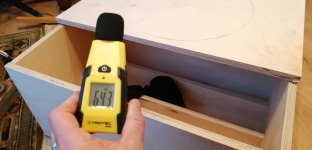
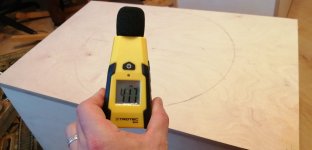
Some damping in and noise through box is now about 30db down. Unfortunately the lid was fully off so not directly comparable 😀 and added weight on top, so also not directly comparable 😀 Well, take as is.

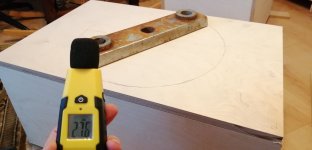
edit. very unscientific test I took recently, empty box with bluetooth speaker inside playing pink noise, and then box with damping in. Difference of about 10db measured with some SPL meter I have, probably not much lows either on the speaker or SPL meter (A weighting I believe) though. Subjectively there is quite a big difference on the sound. I was surprised how much treble comes out when there is no damping, like there was no box at all almost.
Empty box, the baffle is there just laying, no sealing or anything. Noise through box seems to be about 20db down.


Some damping in and noise through box is now about 30db down. Unfortunately the lid was fully off so not directly comparable 😀 and added weight on top, so also not directly comparable 😀 Well, take as is.


Last edited:
What sort of noise is it? Some resonance from the structure? Echoes from standing waves? I don’t really understand the underlying physics of this 🙂
Probably all kinds of things combined, the mid range just becomes a mess, mölinä in Finnish 😀 Its hard to say what is responsible for the perceived sound in any situation, as there is a lot of variables. Safest thing is to assume worst problem dominates, but the sound is combination of multiple things. When you get the speakers running, listen low level and it sounds nice yeah, turn it up and suddenly nice sound is gone, sound transforms to something else.
It could be the box, it could be amp or drivers, how the system interacts with room, even hearing. If it sounds like a box, it probably is the box though 😀 or combination of things, but the box would be the first thing to revisit.
Takeaway is that box might be fine for typical listening levels. If one wants to improve it for some reason then listen louder to hear the issues better.
edit. AI explains it
"Mölinä" is a term often used to describe loud, disorganized, or confused noise or conversation. For instance, it could refer to a large crowd of people where many individuals are speaking simultaneously, making it difficult to distinguish individual words or sentences.
"Mölinä" can also refer to noise that is of a disturbing or unwanted nature, such as music played at an excessively high volume or continuous construction noise. However, the interpretation of the term in this context can depend on the situation and an individual's personal perspective.
It could be the box, it could be amp or drivers, how the system interacts with room, even hearing. If it sounds like a box, it probably is the box though 😀 or combination of things, but the box would be the first thing to revisit.
Takeaway is that box might be fine for typical listening levels. If one wants to improve it for some reason then listen louder to hear the issues better.
edit. AI explains it
"Mölinä" is a term often used to describe loud, disorganized, or confused noise or conversation. For instance, it could refer to a large crowd of people where many individuals are speaking simultaneously, making it difficult to distinguish individual words or sentences.
"Mölinä" can also refer to noise that is of a disturbing or unwanted nature, such as music played at an excessively high volume or continuous construction noise. However, the interpretation of the term in this context can depend on the situation and an individual's personal perspective.
Last edited:
I usually don't listen to music louder than maybe 80dB anyway, I will crank up the volume and see how it goes 😀
I have these adhesive gaskets which come with the speakers, should I use them or are they typically for roadside PA stuff to prevent liquid or various stuff to enter the box?
I have these adhesive gaskets which come with the speakers, should I use them or are they typically for roadside PA stuff to prevent liquid or various stuff to enter the box?
And near field:

This looks pretty good I think for a 200-1800 xover.
hi
can you share distortion measurments for this driver (nearfield, with and without XO). I'm interested in smaller version 8PR320 and it would be interesting to check how bigger version performs
- Home
- Loudspeakers
- Multi-Way
- My FaitalPro 3 way prototype
